by the Night Writer
Anthropoid, adj. – resembling a human being in form.
Anthropoid was the code name for the Allied mission to parachute Czech army-in-exile commandos into Czechoslovakia in World War II to assassinate Reinhard Heydrich, head of the Nazi security organization, acting Reichsprotektor of the Protectorate of Bohemia and Moravia, and the third-highest ranking Nazi leader behind Hitler and Himmler. He was also one of the main architects of “The Final Solution” to exterminate the Jewish race, and the one with the responsibility (and the passion) to carry this out.
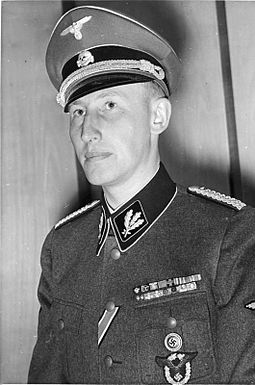 Cold and aristocratic in appearance, Heydrich was the Nazi villain straight out of Central Casting. Czechoslovakia (what was left after the Sudetenland was given away to Hitler by the Munich Agreement) was invaded by and annexed by Germany in 1939, and Heydrich arrived in Prague in 1941 to replace the former Reichsprotektor, Konstantin von Neurath. Neurath was a diplomat by training and favored a more tolerant approach to maintaining order in the dispossessed country. His approach fell out of favor with the Nazi high command due to an active Czech Resistance that organized worker strikes and acts of sabotage to hinder the Czech manufacturing objectives so vital to the German war effort. Upon his arrival, Heydrich quickly earned the nickname “The Butcher of Prague” with his ruthless decimation of the Resistance resulting in thousands of people being executed, arrested or taken hostage as leverage against further acts.
Cold and aristocratic in appearance, Heydrich was the Nazi villain straight out of Central Casting. Czechoslovakia (what was left after the Sudetenland was given away to Hitler by the Munich Agreement) was invaded by and annexed by Germany in 1939, and Heydrich arrived in Prague in 1941 to replace the former Reichsprotektor, Konstantin von Neurath. Neurath was a diplomat by training and favored a more tolerant approach to maintaining order in the dispossessed country. His approach fell out of favor with the Nazi high command due to an active Czech Resistance that organized worker strikes and acts of sabotage to hinder the Czech manufacturing objectives so vital to the German war effort. Upon his arrival, Heydrich quickly earned the nickname “The Butcher of Prague” with his ruthless decimation of the Resistance resulting in thousands of people being executed, arrested or taken hostage as leverage against further acts.
Into this background, a squad of free Czech soldiers were parachuted into the forests near Prague to support the remaining Resistance and be as disruptive as possible. Two soldiers, Jozef Gabcík, (apologies: this blog tool can’t show Czech symbols for proper pronunciation) a Slovakian, and Jan Kubis, a Czech, had the specific assignment to assassinate Heydrich. The plan was almost laughable in its lack of detail: “Ok, lads, drop into occupied territory with minimal equipment and an outdated list of contacts (already dead or arrested) and, you know, use your training to figure something out. Oh, and good luck.”
The details of how they went about this are well, and compellingly, described in the 2016 film, Anthropoid. Ultimately, Gabcík and Kubis were able to find a prime corner in Prague where Heydrich’s Mercedes convertible would have to slow down to turn and on May 27, 1942 they attempted an ambush. Gabcík’s Sten submachine gun jammed, however when he stepped in front of the car to fire at Heydrich. When the offended Heydrich ordered his driver to stop so he could shoot at Gabcík (rather than commanding him to speed away), Kubis tried to lob a modified tank grenade into the open car, but it landed just short, with the explosion nevertheless driving shrapnel and pieces of upholstery into Heydrich’s body. As Gabcík and Kubis fled the scene, Heydrich was taken to a nearby hospital where he died a week later from septic shock caused by toxins in the upholstery of his car in a time before penicillin. Despite an immediate and thorough house-to-house search, Gabcík and Kubis and the other Czech soldiers (with the exception of Karil Curda, who fled prior to the attack to his mother’s home outside Prague) who had parachuted in were successfully hidden in a secret crypt beneath the floor of the Eastern Orthodox Church of Sts. Cyril and Methodius in Prague. German reprisals were immediate and heavy-handed. Some 13,000 people were arrested and as many as 5,000 are estimated to have been executed in an effort to find the assassins and identify those who had helped. Perhaps motivated by a desire to halt the harsh tactics, or the appeal of the promised cash reward, Curda turned himself in to the Gestapo and identified the safe houses and families involved in the plot. These were raided and the people tortured until the hiding place in the church was revealed.
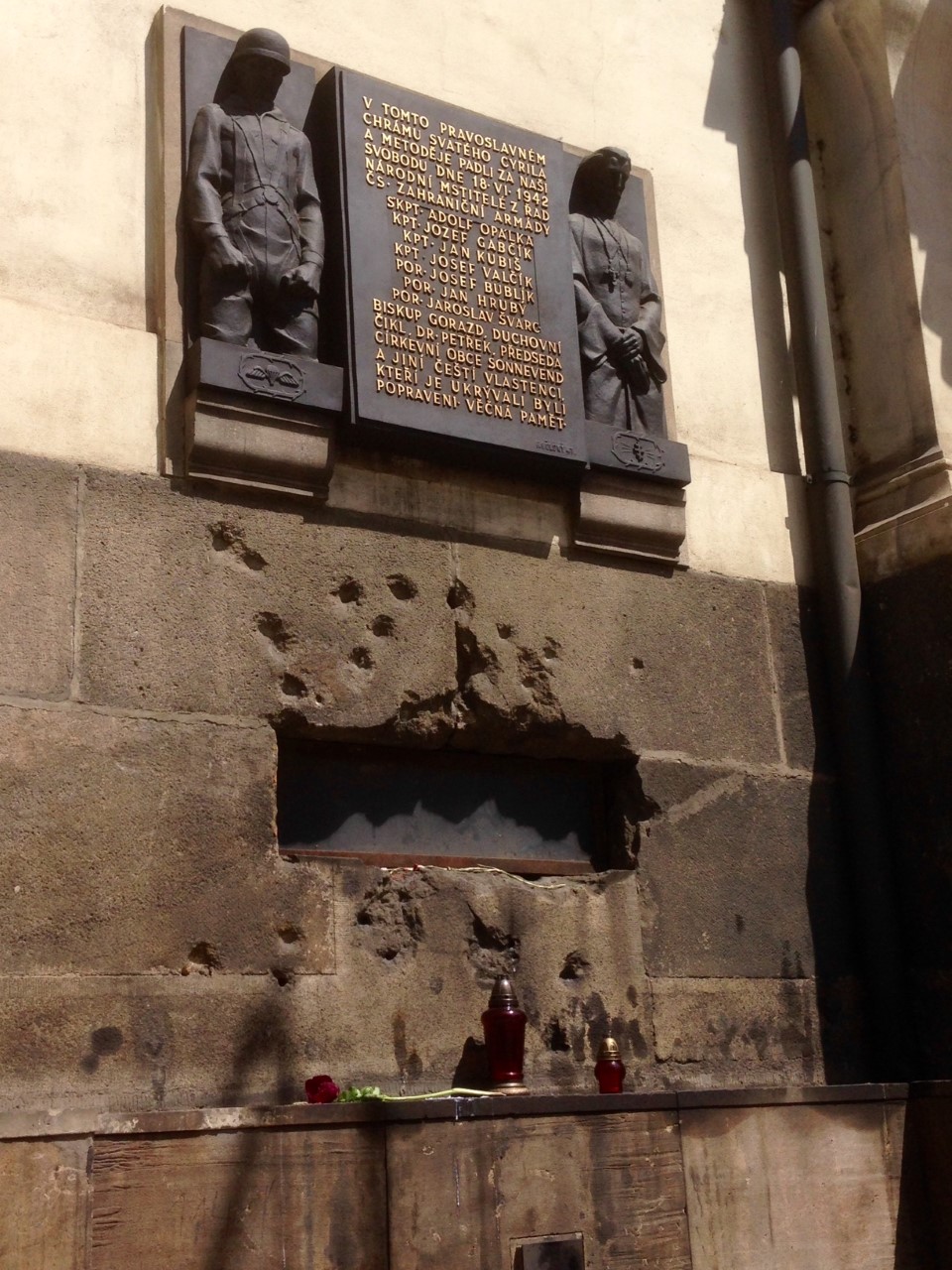
The wall of Sts. Cyril and Methodius church where the final shoot-out happened. Bullet holes frame the vent in the wall in which the fire department flooded the crypt. The plaque commemorates the battle and sacrifice. Ultimately, the priest, the bishop and the leaders of the church and their families were executed by the Nazis for harboring the Czech paratroopers.
On June 18 the army and SS surrounded the church, resulting in a day-long shoot out with the paratroopers holed up there. The local fire department was pressed into service as well to flood the crypt where the few survivors were holed up. Grenades, tear-gas and bullets were also poured into the crypt, while several German soldiers were killed and wounded in the attempt. Each surviving Czech paratrooper ended up committing suicide by bullet or cyanide. Their bodies were identified by Curda, who was later executed himself.
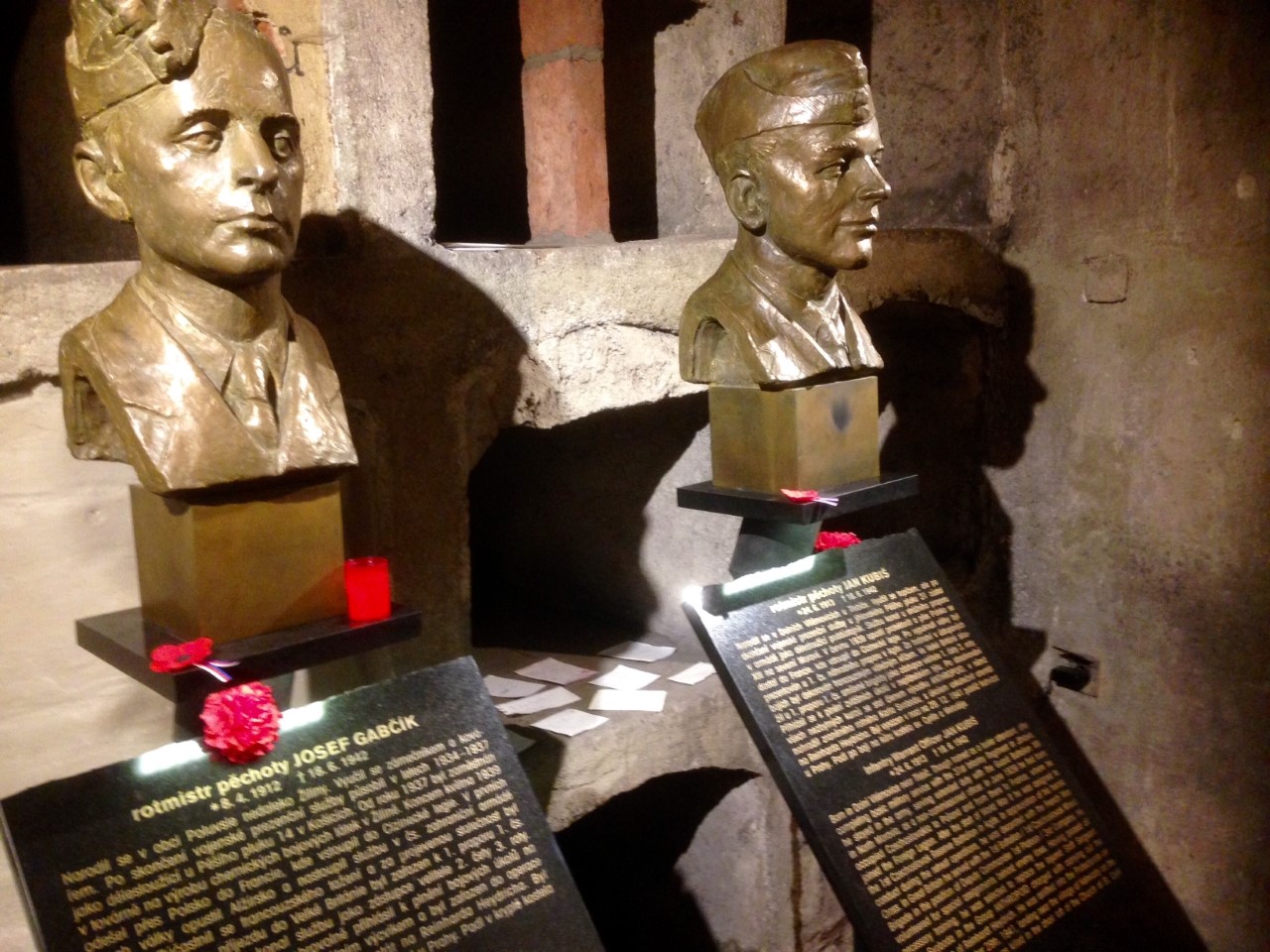
Busts of Gabcik and Junis inside the crypt where the survivors took shelter.
We arrived the weekend after the 75th anniversary commemoration at the church. In addition to the bronze (and bullet holes) on the outer wall, you can visit a small museum inside that details the events (including the Munich Agreement) that led up to the Heydrich assassination and what followed. You can also enter the crypt where the final moments of the story took place. It is a sobering and thought-provoking visit, and I removed my hat as soon as I was inside and kept it off throughout our tour.
The repercussions of the assassination were not just felt by the people of Prague. Hitler’s immediate desire was that 10,000 Czechs be rounded up at random and executed as punishment. The practical Himmler suggested that would have a negative impact on manufacturing production, and suggested an alternative plan.
Lidice
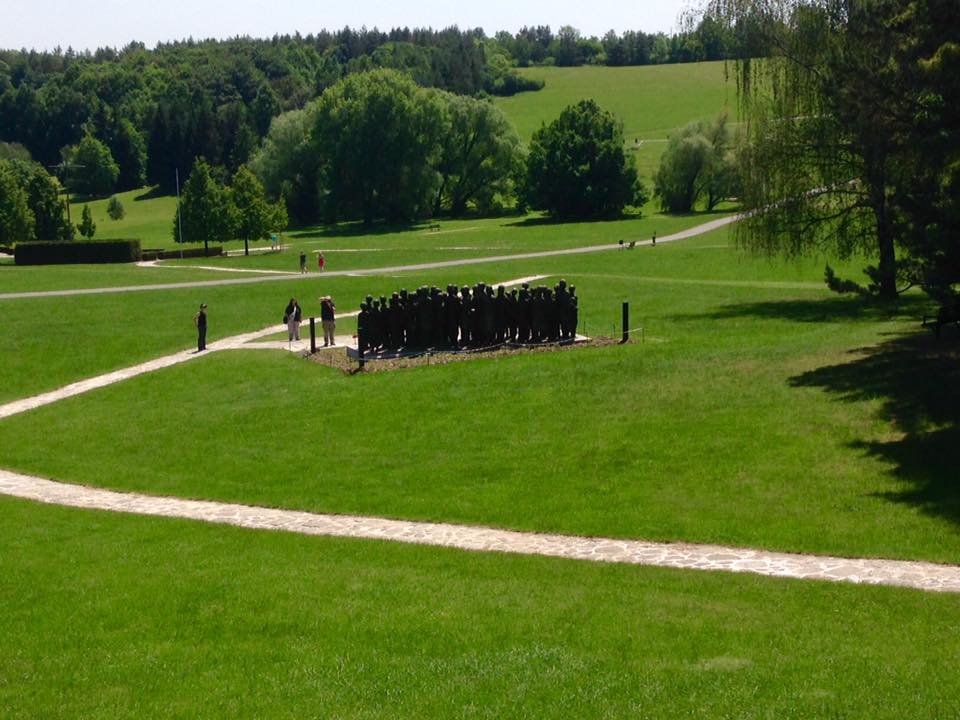
The plain that was once the location of the village of Lidice.
On June 2, 2017, I stood in the bright sunlight, gazing at a rolling field of green with several groves of trees and some benches that looked as if it could host a golf course.
75 years prior, on June 2, 1942, a photographer also came here, to what was the village of Lidice (LEE-deet-say) to take photos of the schoolchildren. One week later, on the night of June 9, the German army and Gestapo also came – and surrounded the village.
The village consisted of just under 500 people; a bit larger than the town of Lytton, Iowa where my daughter and her family live. The men, women and children were rousted from their beds, rounded up and separated. Beginning at 7:00 a.m. on June 10, 173 men, age 15 and older, were lined up against the wall of the Horák barn, originally in groups of 5, and shot. Three riflemen were committed to each target and then a Gestapo officer shot each fallen man again in the head. The next group was brought to the wall, stepping over the bodies of those before them. Because it was taking so long, the groups were increased to 10 at a time. Later, another 11 men of Lidice who were not in the village at the time were executed in Prague, along with two teens originally thought to be 14 and spared until school records revealed they had turned 15 weeks before the massacre.
203 women and 105 children were taken away. Four pregnant women were taken to the Prague hospital where Reinhard Heydrich died after the Operation Anthropoid assassination attempt on his life that sparked the Lidice reprisal. The four women underwent forced abortions and were sent to concentration camps. The other Lidice women were sent to Ravensbruck labor camp. Orders were given that the children of Lidice were sent elsewhere with instructions to receive minimal care. Some died quickly. Another 7 were judged to be Aryan enough to be “Germanized” and were distributed to SS families for adoption. On July 2, one month after the photographer visited them, the remaining 82 children were gassed to death at the Chelmo extermination camp.
Lidice itself was wiped from the map. The 96 homes, the church, the city hall, the school: everything was burned, then the ruins exploded, and topsoil brought in to cover it all. The graves in the cemetery were opened and looted, and the remains destroyed. The stream that ran through the village was rerouted, as were the roads leading in and leading out. Nazi propaganda proudly broadcast the news throughout occupied territory and to the West as an example for others. Several towns around the world renamed themselves in a show of support and defiance. Only a handful of Lidice women ever returned.
After the war, sculptor Marie Uchytilová devoted most of her life to creating bronze statues of the murdered children, working from the photographs taken a week before the massacre. The children stand now near the edge of their village, looking toward the mass grave of their fathers and brothers.
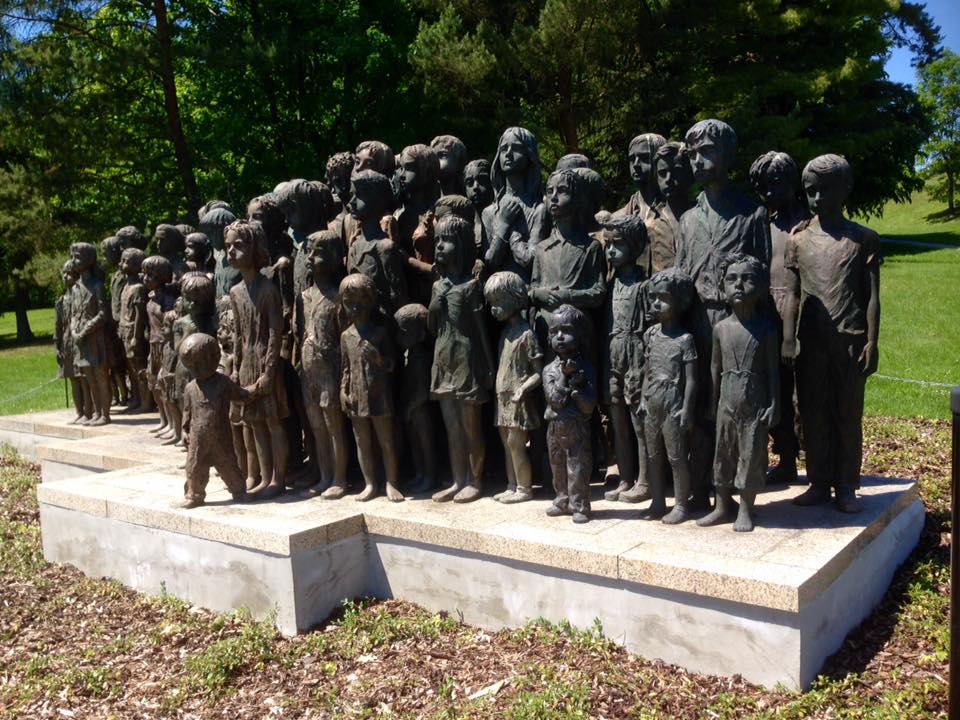
The children of Lidice.
My own eyes follow their line of sight, squinting. How can the sun shine so brightly, and the grass be so green, after what has happened here? The sound of a chainsaw rising and falling in a grove below me sounds, at a distance, like the laboring diesel of a tank or bulldozer. And I can’t stop squinting.
Was it worth it? Could the death of Heydrich justify all that was to come? Would even worse things have happened if Heydrich had lived? Is there a point to considering a single atrocity in a war full of atrocities on all sides?
This post is largely about the facts of what happened in Prague and Lidice (and I did not mention that much the same fate was visited upon the village of Lezacky). You are welcome to your own thoughts. In an upcoming post, I will share mine about the “lessons” learned here.











